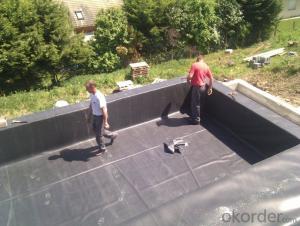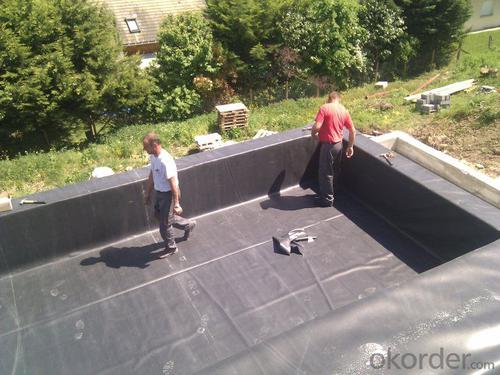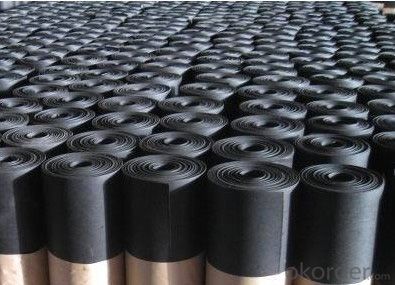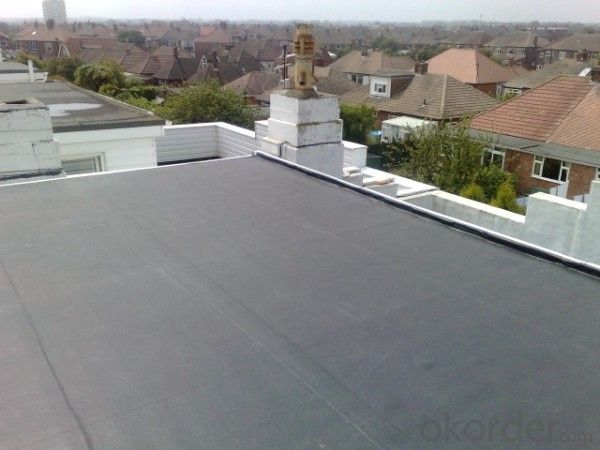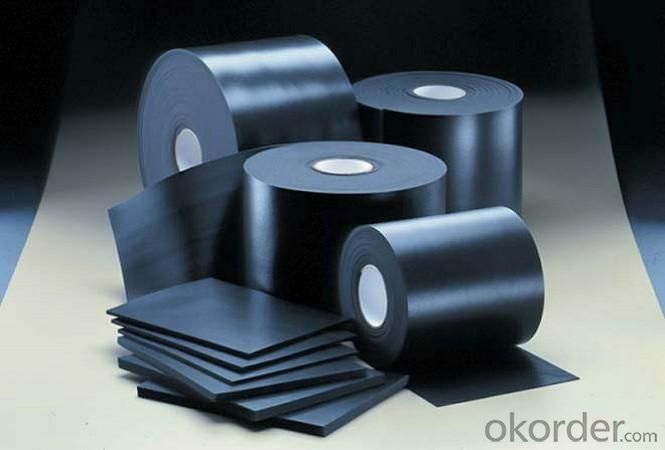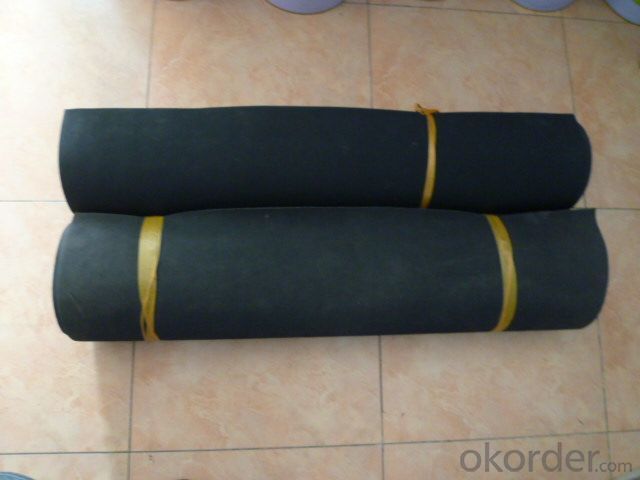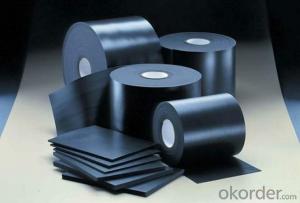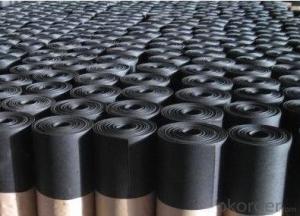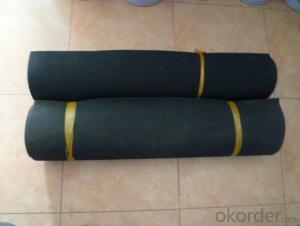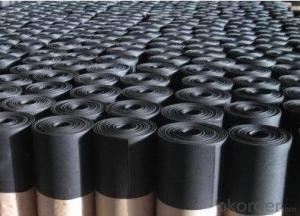EPDM Rubber Waterproof Membrane with Personalized Width
- Loading Port:
- Shanghai
- Payment Terms:
- TT OR LC
- Min Order Qty:
- 50000 m²
- Supply Capability:
- 5000000 m²/month
OKorder Service Pledge
OKorder Financial Service
You Might Also Like
EPDM Rubber Waterproof Membrane with Personalized Width
Description Of EPDM Rubber Waterproof Membrane with Personalized Width:
This waterproof coiled material is of high elasticity with best performance among high polumer waterproof coiled material in the world.It is also the most typical one in the world.Waterproof coiled material made of ternary ethylene-propylene rubber is produced with the use of the most advanced contiuous extrusion and vulcanization technology and related equipments which are specially designed for production of such product.It is good in compactness,without bubble and performance difference in length and breadth,perfomances reach or exceed the demands of GB18173.1-2000 standard.
Main Features of EPDM Rubber Waterproof Membrane with Personalized Width:
1.EPDM waterproof membrane for bridge engineering waterproof
2.EPDM waterproof membrane for water conservancy projects ,such as river bank,lake dam seepage.
3.EPDM waterproof membrane for the municipal engineering.
4.EPDM waterproof membrane for aquaculture.
Specifications of EPDM Rubber Waterproof Membrane with Personalized Width:
| Number | Item | Unit | Value | |
| 1 | Size Variation | Thichness | % | ±10 |
| Width | % | ±1 | ||
| Length | % | Allowed negative | ||
| 2 | Breaking tensile strength at normal temperature | Mpa | ≥7.5 | |
| Breaking tensile strength at 70°C | Mpa | ≥2.3 | ||
| 3 | Breaking elongation at normal temperature | % | ≥450 | |
| Breaking elongation at -20°C | % | ≥200 | ||
| 4 | Tear strength | KN/m | ≥25 | |
| 5 | Impermeability(30min) | * | 0.3Mpa no leakage | |
| 6 | Bending at low tempreture | °C | ≤-40 | |
| 7 | Stretch tensor at heating | Elongate | mm | ≤2 |
| Shrink | mm | ≤4 | ||
| 8 | Air oven aging(80°C×168h) | Tensile strength at break retained | % | ≥80 |
| Elongation at break retained | % | ≥70 | ||
| 9 | Anti-alkali | Tensile strength at break retained | % | ≥80 |
| Elongation at break retained | % | ≥80 | ||
| 10 | Nuture weathing at manual simulation | Tensile strength at break retained | % | ≥80 |
| Elongation at break retained | % | ≥70 | ||
Applications of EPDM Rubber Waterproof Membrane with Personalized Width:
Widely used in roofs, basement, toilet ,swimming pool, and all kinds of industry and civil building waterproofing, reservoir, vivicism, bridge, underground, tunnel and dam waterproofing ,especially to the keystone waterproofing projects which is durability, high corrosion resistance and easy deformation.



IMages of EPDM Rubber Waterproof Membrane with Personalized Width:




FAQ of EPDM Rubber Waterproof Membrane with Personalized Width:
1. What are we supplying?
We are specialized in producing Colorful Asphalt Roof Shingle, SBS/APP modified bitumen waterproof membrane, Self adhesive bitumen waterproof membrane, PVC waterproofing membrane, EPDM rubber roofing membrane, Single Component Polyurethane Waterproof Coating, and Spray Polyurea Waterproof Coating
.
2. How Many years experience do we have?
We have been exported to more than 20 countries in the past 15 years.
3. How long do we usually reply your request?
We always reply our customer within 24 hours.
- Q: Can a waterproofing membrane be applied on any surface?
- When applying a waterproofing membrane, it is essential to take into account the unique characteristics and needs of each surface. Although many waterproofing membranes are versatile and can adhere to different materials, it is advisable to seek advice from a professional or the manufacturer to ensure compatibility and optimal performance. For concrete surfaces, waterproofing membranes are effective in preventing water penetration and safeguarding against moisture damage. These membranes are specifically designed to bond with concrete and create a barrier against water and vapor transmission. However, it is crucial to thoroughly prepare the concrete surface by cleaning it, fixing any cracks or imperfections, and ensuring a smooth and even substrate for the membrane to adhere to. Similarly, masonry surfaces such as brick or stone can benefit from the application of waterproofing membranes. These surfaces may require additional preparation, such as the removal of loose mortar or debris, and might benefit from using a primer to enhance adhesion. The porosity and texture of these surfaces may also influence the choice of waterproofing membrane. Wood surfaces, such as decks or balconies, can be protected against moisture damage and have their lifespan extended by applying a waterproofing membrane. However, it is important to select a membrane specifically designed for wood surfaces, as these materials require additional flexibility to accommodate the natural movement and expansion of wood. In conclusion, while waterproofing membranes can be used on a variety of surfaces, it is crucial to consider the specific characteristics and preparation requirements of each surface to achieve the best results. Seeking guidance from a professional or the manufacturer can help determine the most suitable membrane and application method for a particular surface.
- Q: Can a waterproofing membrane be used in swimming pools or water features?
- Swimming pools or water features can benefit from the use of a waterproofing membrane. This type of membrane is commonly employed in these scenarios to establish a barrier between the water and the surrounding structure. By doing so, it prevents any water leakage and structural damage, ultimately ensuring the swimming pool or water feature's longevity and durability. Typically, the membrane is applied to the structure's surface and can be composed of various materials like rubber, PVC, or bitumen. It is imperative to select a membrane specifically designed for underwater applications to guarantee its effectiveness in providing a watertight seal. Furthermore, proper installation and regular maintenance of the waterproofing membrane are vital to uphold its long-term performance.
- Q: Can a waterproofing membrane be used on breeze block surfaces?
- Using a different grammatical structure and expressions: Indeed, breeze block surfaces can benefit from the application of a waterproofing membrane. These concrete blocks, also known as breeze blocks, are commonly utilized in construction due to their porous nature. This porosity allows water to infiltrate the blocks, which can potentially lead to dampness or water-related harm within the building. To counteract this issue, the surface of the breeze blocks can be treated with a waterproofing membrane. A waterproofing membrane is a thin layer of material specifically designed to impede water penetration. It acts as a protective barrier, preventing water from seeping into the breeze blocks and safeguarding the underlying structure against moisture damage. This membrane is typically applied in either liquid or sheet form and securely adhered to the surface of the breeze blocks using an appropriate adhesive. Prior to applying the waterproofing membrane, it is crucial to adequately prepare the surface of the breeze blocks. This may involve thorough cleaning to ensure the absence of loose debris or contaminants. Additionally, any existing cracks or gaps in the breeze blocks should be addressed and repaired prior to the membrane application. This meticulous preparation is necessary to achieve a seamless and effective waterproofing system. It is important to note that the selection of the appropriate waterproofing membrane depends on the specific requirements of the project and the conditions to which the breeze block surface will be exposed. There are several types of waterproofing membranes available, such as liquid-applied membranes, sheet membranes, or cementitious coatings. To determine the most suitable membrane for your particular application, it is advisable to consult with a professional or the manufacturer. In conclusion, the utilization of a waterproofing membrane on breeze block surfaces is an effective means of preventing water penetration and safeguarding the underlying structure against moisture damage. Proper surface preparation and careful consideration of the appropriate membrane type are vital elements in achieving a successful waterproofing solution.
- Q: Can a waterproofing membrane be used in high-traffic areas?
- Yes, a waterproofing membrane can be used in high-traffic areas. These membranes are designed to provide a protective barrier against water and moisture, making them suitable for use in areas that experience heavy foot traffic. They are durable, resistant to wear and tear, and can help prevent water damage and leakage in such areas.
- Q: Can a waterproofing membrane be used for temporary structures or tents?
- Yes, a waterproofing membrane can be used for temporary structures or tents. Waterproofing membranes are designed to provide a protective barrier against water, preventing it from penetrating the surface and causing damage. This makes them an ideal choice for temporary structures or tents, as they can effectively keep the interior dry during rain or other wet conditions. Additionally, waterproofing membranes are often lightweight and flexible, making them easy to install and remove, which is especially beneficial for temporary structures or tents that may need to be relocated or dismantled.
- Q: Does a waterproofing membrane require any special maintenance?
- Yes, a waterproofing membrane does require some special maintenance. It is important to regularly inspect the membrane for any damages or signs of wear and tear. Additionally, periodic cleaning and removal of debris is necessary to ensure its effectiveness. Proper drainage and regular resealing or reapplying of waterproofing coatings may also be needed to maintain the membrane's longevity and functionality.
- Q: Can a waterproofing membrane be used in ponds or reservoirs?
- Yes, a waterproofing membrane can be used in ponds or reservoirs. Waterproofing membranes are designed to create a barrier that prevents water from seeping through, making them an effective solution for creating a watertight seal in ponds or reservoirs.
- Q: Can waterproofing membranes be used on underground tunnels?
- Underground tunnels can indeed utilize waterproofing membranes. These specialized membranes are crafted to create a barrier against water infiltration and are widely employed in various construction contexts, including subterranean structures like tunnels. Typically composed of materials such as bitumen, asphalt, or synthetic rubber, these membranes possess exceptional waterproofing capabilities. Once applied to the walls and floors of a tunnel, waterproofing membranes establish a protective layer that hinders water from permeating into the tunnel. This becomes particularly crucial in underground tunnels, as they are vulnerable to water intrusion from the surrounding soil or groundwater. By implementing waterproofing membranes, the integrity and longevity of the tunnel structure are preserved, minimizing the risk of water damage, corrosion, and deterioration. Moreover, waterproofing membranes yield additional advantages, such as resistance against chemical attacks, prevention of mold and mildew growth, and enhancement of overall tunnel insulation. These membranes can be employed either during the construction phase of the tunnel or as a retrofit solution for existing tunnels. It is essential to note that the choice of the appropriate waterproofing membrane should be based on factors such as the tunnel type, anticipated water pressure, and overall design requirements. Seeking guidance from a professional engineer or waterproofing specialist is highly recommended to ensure the selection and installation of the most suitable waterproofing membrane for underground tunnels.
- Q: Can a waterproofing membrane be used for data centers?
- Yes, a waterproofing membrane can be used for data centers. A waterproofing membrane is designed to prevent water infiltration, which is crucial for protecting sensitive equipment and critical data in a data center. Water damage can result in costly downtime and data loss, making it essential to have reliable waterproofing measures in place. By applying a waterproofing membrane to the walls, floors, and ceilings of a data center, it can create a barrier that prevents water leaks and moisture buildup. This helps to maintain a controlled and dry environment, ensuring the safety and functionality of the data center's infrastructure and equipment. Additionally, some waterproofing membranes also offer insulation properties, further enhancing the protection and energy efficiency of the data center.
- Q: Can a waterproofing membrane be used for basements and crawl spaces?
- Yes, a waterproofing membrane can be used for basements and crawl spaces. In fact, it is highly recommended to use a waterproofing membrane in these areas to prevent water damage and moisture issues. A waterproofing membrane is a thin layer of material that is applied to the walls and floors of a basement or crawl space to create a barrier against water and moisture. This helps to keep the area dry and prevent water from seeping into the space, which can cause structural damage, mold growth, and other problems. Waterproofing membranes are designed to be durable and long-lasting, providing a reliable solution for protecting basements and crawl spaces from water intrusion.
Send your message to us
EPDM Rubber Waterproof Membrane with Personalized Width
- Loading Port:
- Shanghai
- Payment Terms:
- TT OR LC
- Min Order Qty:
- 50000 m²
- Supply Capability:
- 5000000 m²/month
OKorder Service Pledge
OKorder Financial Service
Similar products
Hot products
Hot Searches
Related keywords
